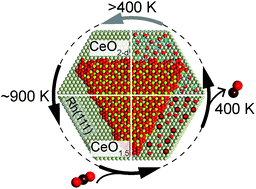当前位置:
X-MOL 学术
›
Phys. Chem. Chem. Phys.
›
论文详情
Our official English website, www.x-mol.net, welcomes your feedback! (Note: you will need to create a separate account there.)
Thermal reduction of ceria nanostructures on rhodium(111) and re-oxidation by CO2†
Physical Chemistry Chemical Physics ( IF 3.3 ) Pub Date : 2018-07-03 00:00:00 , DOI: 10.1039/c8cp01505h Andreas Schaefer 1, 2, 3, 4, 5 , Benjamin Hagman 4, 5, 6, 7 , Jan Höcker 8, 9, 10, 11, 12 , Uta Hejral 4, 5, 6, 7 , Jan Ingo Flege 8, 9, 10, 11, 12 , Johan Gustafson 4, 5, 6, 7
Physical Chemistry Chemical Physics ( IF 3.3 ) Pub Date : 2018-07-03 00:00:00 , DOI: 10.1039/c8cp01505h Andreas Schaefer 1, 2, 3, 4, 5 , Benjamin Hagman 4, 5, 6, 7 , Jan Höcker 8, 9, 10, 11, 12 , Uta Hejral 4, 5, 6, 7 , Jan Ingo Flege 8, 9, 10, 11, 12 , Johan Gustafson 4, 5, 6, 7
Affiliation

|
The thermal reduction of cerium oxide nanostructures deposited on a rhodium(111) single crystal surface and the re-oxidation of the structures by exposure to CO2 were investigated. Two samples are compared: a rhodium surface covered to ≈60% by one to two O–Ce–O trilayer high islands and a surface covered to ≈65% by islands of four O–Ce–O trilayer thickness. Two main results stand out: (1) the thin islands reduce at a lower temperature (870–890 K) and very close to Ce2O3, while the thicker islands need higher temperature for reduction and only reduce to about CeO1.63 at a maximum temperature of 920 K. (2) Ceria is re-oxidized by CO2. The rhodium surface promotes the re-oxidation by splitting the CO2 and thus providing atomic oxygen. The process shows a clear temperature dependence. The maximum oxidation state of the oxide reached by re-oxidation with CO2 differs for the two samples, showing that the thinner structures require a higher temperature for re-oxidation with CO2. Adsorbed carbon species, potentially blocking reactive sites, desorb from both samples at the same temperature and cannot be the sole origin for the observed differences. Instead, an intrinsic property of the differently sized CeOx islands must be at the origin of the observed temperature dependence of the re-oxidation by CO2.
中文翻译:

铑(111)上二氧化铈纳米结构的热还原和CO 2 †的再氧化
研究了沉积在铑(111)单晶表面上的氧化铈纳米结构的热还原以及通过暴露于CO 2对该结构的再氧化。比较了两个样本:一个到两个O–Ce–O三层高岛的铑表面覆盖了≈60%的表面,被四个O–Ce–O三层厚度的岛覆盖了≈65%的表面。有两个主要结果:(1)较薄的岛在较低的温度(870–890 K)处还原并且非常接近Ce 2 O 3,而较厚的岛需要较高的温度进行还原,而在较低的温度下仅还原至CeO 1.63左右。最高温度为920K。(2)二氧化铈被CO 2再氧化。铑表面通过分解一氧化碳促进再氧化2从而提供原子氧。该过程显示出明显的温度依赖性。通过CO 2再氧化达到的氧化物的最大氧化态对于两个样品是不同的,这表明较薄的结构需要更高的温度才能用CO 2再氧化。吸附的碳物质(可能会阻塞反应位点)会在相同温度下从两个样品中解吸出来,并且不是观察到的差异的唯一来源。取而代之的是,不同尺寸的CeO x岛的内在特性必须源自观察到的CO 2再氧化的温度依赖性。
更新日期:2018-07-03
中文翻译:

铑(111)上二氧化铈纳米结构的热还原和CO 2 †的再氧化
研究了沉积在铑(111)单晶表面上的氧化铈纳米结构的热还原以及通过暴露于CO 2对该结构的再氧化。比较了两个样本:一个到两个O–Ce–O三层高岛的铑表面覆盖了≈60%的表面,被四个O–Ce–O三层厚度的岛覆盖了≈65%的表面。有两个主要结果:(1)较薄的岛在较低的温度(870–890 K)处还原并且非常接近Ce 2 O 3,而较厚的岛需要较高的温度进行还原,而在较低的温度下仅还原至CeO 1.63左右。最高温度为920K。(2)二氧化铈被CO 2再氧化。铑表面通过分解一氧化碳促进再氧化2从而提供原子氧。该过程显示出明显的温度依赖性。通过CO 2再氧化达到的氧化物的最大氧化态对于两个样品是不同的,这表明较薄的结构需要更高的温度才能用CO 2再氧化。吸附的碳物质(可能会阻塞反应位点)会在相同温度下从两个样品中解吸出来,并且不是观察到的差异的唯一来源。取而代之的是,不同尺寸的CeO x岛的内在特性必须源自观察到的CO 2再氧化的温度依赖性。



























 京公网安备 11010802027423号
京公网安备 11010802027423号